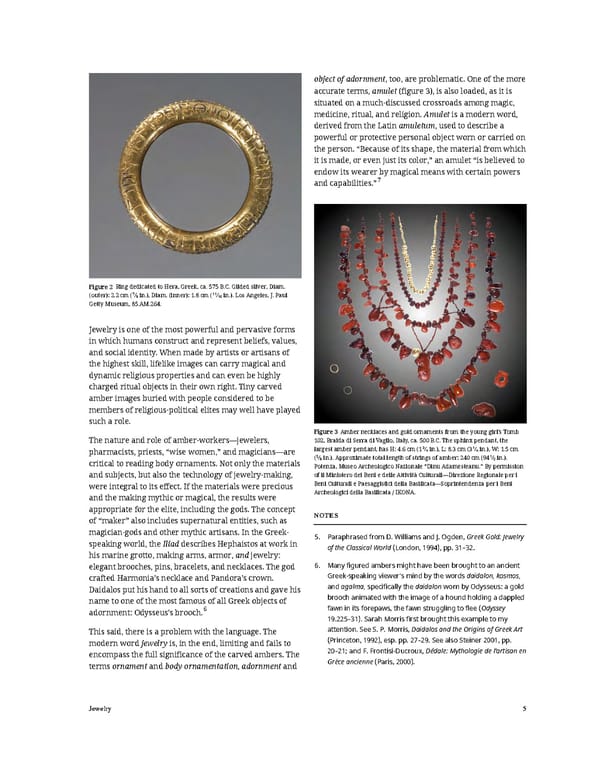object of adornment, too, are problematic. One of the more accurate terms, amulet (figure 3), is also loaded, as it is situated on a much-discussed crossroads among magic, medicine, ritual, and religion. Amulet is a modern word, derived from the Latin amuletum, used to describe a powerful or protective personal object worn or carried on the person. “Because of its shape, the material from which it is made, or even just its color,” an amulet “is believed to endow its wearer by magical means with certain powers and capabilities.”7 Figure 2 Ring dedicated to Hera, Greek, ca. 575 B.C. Gilded silver, Diam. (outer): 2.2 cm (7⁄8 in.), Diam. (inner): 1.8 cm (11⁄16 in.). Los Angeles, J. Paul Getty Museum,85.AM.264. Jewelry is one of the most powerful and pervasive forms in which humans construct and represent beliefs, values, and social identity. When made by artists or artisans of the highest skill, lifelike images can carry magical and dynamic religious properties and can even be highly charged ritual objects in their own right. Tiny carved amber images buried with people considered to be members of religious-political elites may well have played such a role. Figure 3 Amber necklaces and gold ornaments from the young girl’s Tomb The nature and role of amber-workers—jewelers, 102, Braida di Serra di Vaglio, Italy, ca. 500 B.C. The sphinx pendant, the pharmacists, priests, “wise women,” and magicians—are largest amber pendant, has H: 4.6 cm (13⁄4 in.), L: 8.3 cm (31⁄4 in.), W: 1.5 cm (5⁄8 in.). Approximate total length of strings of amber: 240 cm (941⁄2 in.). critical to reading body ornaments. Not only the materials Potenza, Museo Archeologico Nazionale “Dinu Adamesteanu.” By permission and subjects, but also the technology of jewelry-making, of il Ministero dei Beni e delle Attività Culturali—Direzione Regionale per i were integral to its effect. If the materials were precious Beni Culturali e Paesaggistici della Basilicata—Soprintendenza per i Beni and the making mythic or magical, the results were Archeologici della Basilicata / IKONA. appropriate for the elite, including the gods. The concept NOTES of “maker” also includes supernatural entities, such as magician-gods and other mythic artisans. In the Greek- 5. Paraphrased from D. Williams and J. Ogden, Greek Gold: Jewelry speaking world, the Iliad describes Hephaistos at work in of the Classical World (London, 1994), pp. 31–32. his marine grotto, making arms, armor, and jewelry: elegant brooches, pins, bracelets, and necklaces. The god 6. Many figured ambers might have been brought to an ancient crafted Harmonia’s necklace and Pandora’s crown. Greek-speaking viewer’s mind by the words daidalon, kosmos, Daidalos put his hand to all sorts of creations and gave his andagalma,specifically the daidalon worn by Odysseus: a gold name to one of the most famous of all Greek objects of brooch animated with the image of a hound holding a dappled adornment: Odysseus’s brooch.6 fawn in its forepaws, the fawn struggling to flee (Odyssey 19.225–31). Sarah Morris first brought this example to my This said, there is a problem with the language. The attention. See S. P. Morris, Daidalos and the Origins of Greek Art modern wordjewelryis, in the end, limiting and fails to (Princeton, 1992), esp. pp. 27–29. See also Steiner 2001, pp. encompass the full significance of the carved ambers. The 20–21; and F. Frontisi-Ducroux, Dédale: Mythologie de l’artisan en termsornamentandbody ornamentation,adornmentand Grèce ancienne (Paris, 2000). Jewelry 5
 Ancient Carved Ambers in the J. Paul Getty Museum Page 14 Page 16
Ancient Carved Ambers in the J. Paul Getty Museum Page 14 Page 16